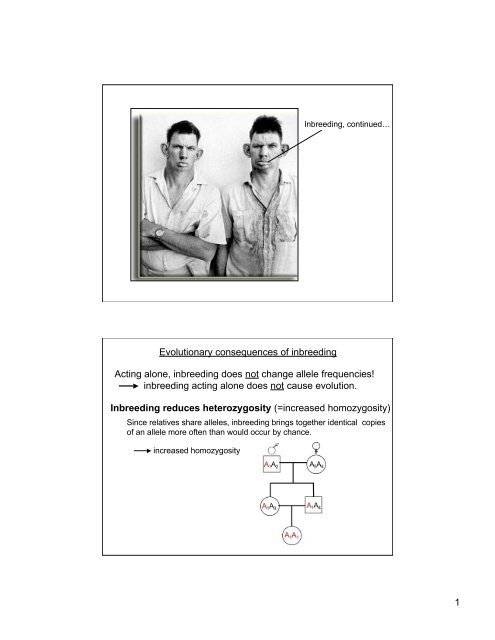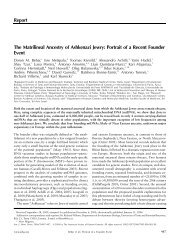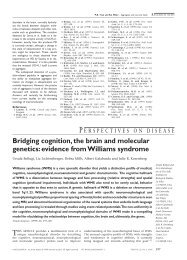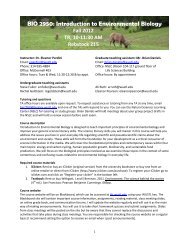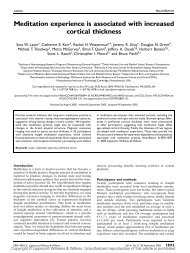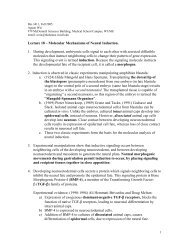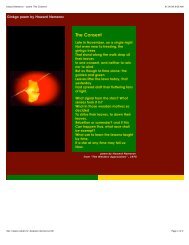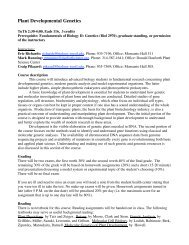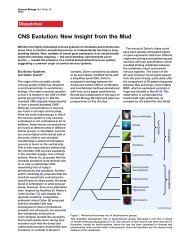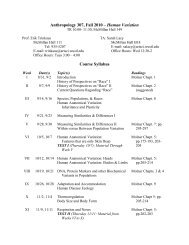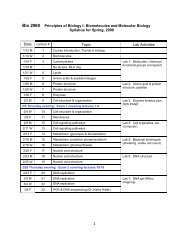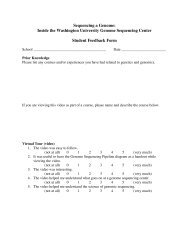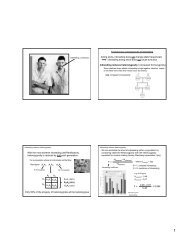increased homozygosity
increased homozygosity
increased homozygosity
You also want an ePaper? Increase the reach of your titles
YUMPU automatically turns print PDFs into web optimized ePapers that Google loves.
Inbreeding, continued…<br />
Evolutionary consequences of inbreeding<br />
Acting alone, inbreeding does not change allele frequencies!<br />
inbreeding acting alone does not cause evolution.<br />
Inbreeding reduces heterozygosity (=<strong>increased</strong> <strong>homozygosity</strong>)<br />
Since relatives share alleles, inbreeding brings together identical copies<br />
of an allele more often than would occur by chance.<br />
<strong>increased</strong> <strong>homozygosity</strong><br />
1
Inbreeding reduces heterozygosity…<br />
With the most extreme inbreeding (self-fertilization),<br />
heterozygosity is reduced by half each generation:<br />
For a population where all individuals self-fertilize:<br />
Genotypes:<br />
A 1 A 1 A 1 A 2 A 2 A 2<br />
All homozygotes<br />
All homozygotes<br />
A 1<br />
A 1 A 2<br />
A 2<br />
A 1 A 1 A 1 A 2<br />
A 1 A 2 A 2 A 2<br />
A 1 A 1 (25%)<br />
A 1 A 2 (50%)<br />
A 2 A 2 (25%)<br />
Only 50% of the progeny of heterozygotes will be heterozygous<br />
Inbreeding reduces heterozygosity…<br />
We can estimate the level of inbreeding within a population by<br />
comparing observed heterozygosity with the heterozygosity<br />
expected for random mating (Hardy-Weinberg expectation: 2pq).<br />
F =<br />
Inbreeding coefficient<br />
H expected - H observed<br />
H expected<br />
where H expected = 2pq<br />
(F= 1: complete inbreeding)<br />
(F< 0: avoidance of inbreeding)<br />
2
Inbreeding reduces heterozygosity…<br />
We can estimate the level of inbreeding within a population by<br />
comparing observed heterozygosity with the heterozygosity<br />
expected for random mating (Hardy-Weinberg expectation: 2pq).<br />
F =<br />
Inbreeding coefficient<br />
H expected - H observed<br />
H expected<br />
where H expected = 2pq<br />
(F= 1: complete inbreeding)<br />
(F< 0: avoidance of inbreeding)<br />
e.g, for B gene:<br />
H expected = 0.48<br />
H observed = 0.07<br />
F =<br />
0.48 - 0.07<br />
0.48<br />
= 0.854<br />
Futuyma Fig. 9.6<br />
Avena fatua<br />
Inbreeding and fitness<br />
Inbreeding depression: reduced fitness due to inbreeding<br />
— ***expression of deleterious recessive alleles (e.g., disease)<br />
— loss of any fitness arising from heterozygote advantage<br />
(Italy, early 20th Century)<br />
Inbreeding can exacerbate expression of disease in populations that<br />
have gone through bottlenecks or founder events.<br />
3
Inbreeding depression may be most evident during times of stress<br />
Survivorship<br />
through the<br />
1989 blizzard<br />
‘Genetic rescue’ from inbreeding depression<br />
e.g., Isolated Swedish adder population (N
Mechanisms that prevent inbreeding in plants<br />
— Self-incompatibility (S-locus alleles can’t be shared)<br />
— Dioecy (male and female flowers on different plants)<br />
— Asynchronous flowering of male and female flowers on a plant<br />
— Heterostyly: 2 or morphological arrangements of stamens and stigmas;<br />
only plants with different arrangements will cross-pollinate<br />
Dioecious species:<br />
(Holly: Ilex sp.)<br />
Mechanisms that prevent inbreeding in animals: behavior<br />
— Dispersal of juveniles<br />
— Recognition of relatives and avoidance of mating with them<br />
e.g., mice avoid mating with individuals with shared alleles<br />
of the major histocompatibility (MHC) locus<br />
5
Not all populations avoid inbreeding<br />
e.g., Fig wasps: siblings mate with each other after hatching<br />
Fig wasp<br />
Not all populations avoid inbreeding<br />
Many plant species are partially or entirely self-fertilizing<br />
Arabidopsis thaliana<br />
(model genetic system)<br />
Rice (Oryza sativa)<br />
and many other crops<br />
Why self-fertilize<br />
Advantages:<br />
1) ***Reproductive assurance (e.g., N=1 founds new population)<br />
2) Low resource investment in attracting mates/pollinators<br />
3) Preserve ‘coadapted gene complexes’: optimal combination<br />
of alleles at different loci in an individual<br />
Nonetheless, self-fertilizing species may be evolutionary ‘dead ends’<br />
Severe inbreeding in a normally outcrossing species<br />
usually leads to population extinction.<br />
e.g., Sewall Wright: 35 guinea pig lines<br />
started from brother-sister matings.<br />
Within 9 years, half went extinct<br />
W = ~0.3 relative to control lines<br />
e.g., Inbred house mice lines<br />
Only 1 line out of 20 persisted to 12<br />
generations<br />
7
An unusual case…<br />
Inbreeding can potentially purge deleterious recessive<br />
alleles from a population (none hiding in heterozygotes)<br />
e.g, Chillingham wild cattle (N300 years of total inbreeding<br />
Complete <strong>homozygosity</strong> at<br />
24 of 25 loci examined<br />
(Other cattle:>70%<br />
heterozygous at the same<br />
loci)<br />
No drop in viability or<br />
fecundity relative to other<br />
cattle.<br />
Sexual Selection<br />
• Viability: probability of survival to reproductive age<br />
• Mating Success<br />
Sexual selection: differential reproductive success<br />
due to differential mating success<br />
• Fecundity: viable offspring<br />
Bright coloration: favored for mating<br />
success — attracts females<br />
Dull coloration: favored for protection from<br />
predators<br />
Guppy (Poecilia sp.)<br />
8
Why is there competition for mates<br />
Sexes differ in energetic costs of reproduction:<br />
-sperm are cheap, eggs are limited<br />
-parenting investment (usually more by mother)<br />
Why is there competition for mates<br />
Two consequences:<br />
Sexes differ in energetic costs of reproduction:<br />
-sperm are cheap, eggs are limited<br />
-parenting investment (usually more by mother)<br />
1) Reproduction is energetically limited for female: she should be choosy<br />
2) Fewer receptive females than males: females are limited resource,<br />
so males will vary in their mating success<br />
Males will compete for females<br />
Exception: if male’s parenting investment exceeds female’s:<br />
female<br />
male<br />
Phalarope (Phalaropus fulicarius)<br />
9
Intrasexual selection: competition between males<br />
1. Direct competition for mates<br />
Male-male competition during copulation<br />
10
Evolutionary consequences of direct competition for mates<br />
Selection for larger size, traits that facilitate fighting success<br />
- leads to dimorphism between sexes<br />
Fitness and male body size: viability vs. mating success<br />
Male marine iguanas are larger than the optimal size for survival,<br />
given available food resources (algae).<br />
11
Intrasexual selection…<br />
Alternative male mating strategy: sneaky males<br />
e.g., many fish species<br />
e.g., dimorphism in male Rhinocerous beetles:<br />
Males that battle for and guard females<br />
vs.<br />
Small males that sneak into females’ tunnels<br />
Disruptive sexual selection on male morphology<br />
Three male mating strategies in lizard:<br />
a) ‘Ultradominant’: territory with multiple females<br />
b) Small, carefully guarded territory: 1 female<br />
c) No territory, sneak in on ultradominants<br />
negative frequency-dependent selection<br />
Side-blotched lizard<br />
Forms of intrasexual selection…<br />
2. Sperm competition:<br />
• Remove competitors’ sperm<br />
• Plug female genitalia following mating<br />
• Produce more sperm (larger testes)<br />
• Repeated matings<br />
Polygamous primates produce<br />
more sperm<br />
Damselfly penis has horn<br />
that removes other males’<br />
sperm<br />
Futuyma, Fig. 14.7<br />
12
Forms of intrasexual selection…<br />
3. Infanticide:<br />
Accounts for 25% of all lion cub deaths in first year of life<br />
10% of lion mortality overall<br />
Puma cub<br />
13
Intersexual selection: mate choice<br />
Females often mate preferentially with showy males<br />
Enlarged, ornamented traits; coloration; vocalization; other<br />
behavior.<br />
Showy male<br />
Drab female<br />
Like intrasexual selection, leads to evolution of sexual dimorphism<br />
Mate choice: female widowbirds prefer longer-tailed males<br />
Futuyma, Fig. 11.9<br />
14
Intersexual selection: mate choice<br />
Leads to trait divergence<br />
among closely related<br />
species.<br />
Traits favored by mate choice my compromise a male’s viability<br />
e.g., guppy coloration with predators<br />
e.g., Vocalizations in túngara frogs:<br />
Physalaemus pustulosis<br />
15
Mate choice: How and why do female preferences arise<br />
Explanation 1: Direct benefits. Females choose traits with<br />
direct benefits for her or her offspring.<br />
e.g., Female birds pick males with best territory, resources.<br />
Mate choice: How and why do female preferences arise<br />
Explanation 1: Direct benefits. Females choose traits with<br />
direct benefits for her or her offspring.<br />
e.g., Female birds pick males with best territory, resources.<br />
e.g., Female hangingflies prefer males who provide larger prey during<br />
mating.<br />
16
Explanation 2: Sensory bias. Intrinsic preference for particular<br />
sensory stimuli. Female’s preference precedes the evolution of the<br />
preferred male trait.<br />
e.g., Prey orientation: lizard movement<br />
Explanation 2: Sensory bias. Intrinsic preference for particular<br />
sensory stimuli. Female’s preference precedes the evolution of the<br />
preferred male trait.<br />
e.g., Prey orientation: lizard movement<br />
e.g., Females of fish species 1 prefer long tails even though no males<br />
possess them: preference predates the species.<br />
Species 1<br />
Species 2<br />
P+: females prefer long tails<br />
T+: males possess long tails<br />
Female preference for long tails<br />
arose before Species 1 and 2<br />
diverged from their common ancestor<br />
17
Sensory bias and female preference…<br />
Zebra finches females prefer males with an artificial white crest<br />
Explanation 3: Indirect benefits. Females prefer males with traits that<br />
indirectly benefit the female or her offspring.<br />
a) “Sexy son” hypothesis (= Runaway sexual selection)<br />
(=“Fisherian model”)<br />
Sons inherit trait that made father attractive to mother (mating success);<br />
favored by future generations of females<br />
These successful<br />
males will pass on the<br />
alleles for the trait<br />
(expressed in their<br />
sons) and the alleles<br />
for the trait preference<br />
(expressed in their<br />
daughters).<br />
18
Explanation 3: Indirect benefits. Females prefer males with traits that<br />
indirectly benefit the female or her offspring.<br />
a) “Sexy son” hypothesis (= Runaway sexual selection)<br />
(=“Fisherian model”)<br />
Sons inherit trait that made father attractive to mother (mating success);<br />
favored by future generations of females<br />
These successful<br />
males will pass on the<br />
alleles for the trait<br />
(expressed in their<br />
sons) and the alleles<br />
for the trait preference<br />
(expressed in their<br />
daughters).<br />
Establishes<br />
genetic correlation<br />
between the trait<br />
(T) and preference<br />
for the trait (P):<br />
Offspring of T 2<br />
males and P 2<br />
females will carry<br />
both T 2 and P 2<br />
alleles.<br />
(Both sexes carry both genes, but each is only expressed in one sex.)<br />
Sexy son hypothesis illustrated: sandfly<br />
Offspring of most vs<br />
least attractive males do<br />
not differ in viability or<br />
fecundity (=no direct<br />
benefits).<br />
Lutzomyia<br />
longipalpis<br />
But sons of attractive<br />
fathers have greatest<br />
mating success.<br />
19


